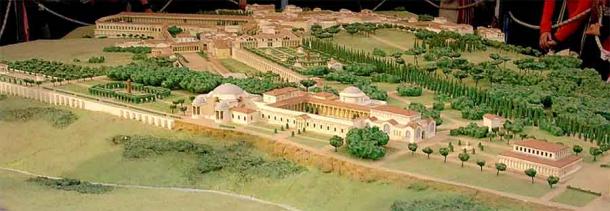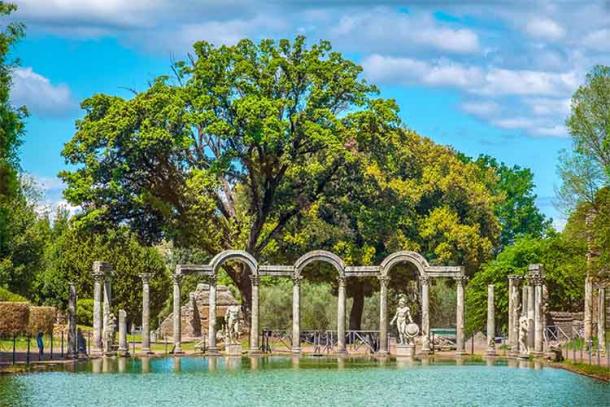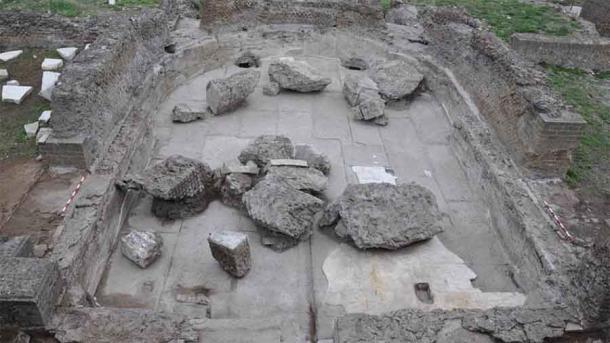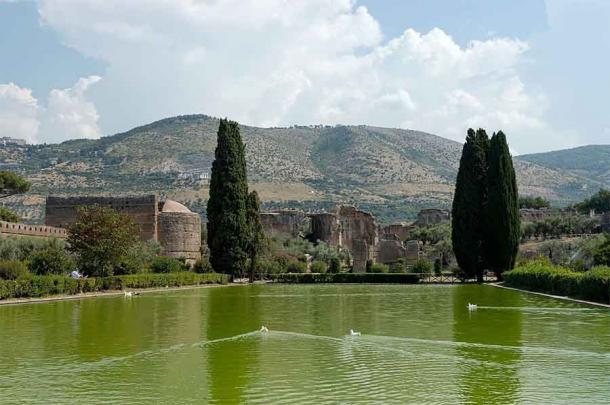Archaeologists excavating at Emperor Hadrian´s villa, a super-famous 1,900-year-old Roman countryside retreat, have discovered his lush breakfasting room. On a semi-circular platform amidst fountains, pools of water and beams of light, the legendary ruler breakfasted daily, displaying his power, and reasserting his semi-divine status. Hadrian’s villa, known as Villa Adriana, was built at the foot of an Apennine mountain at “Tibur,” now called Tivoli, about 20 miles (32 km) east of Rome in 117 AD.
It took around three years to complete the construction of Villa Adriana. Starting in 128 AD, the 200-acre (81 hectare) villa complex became Hadrian´s official residence and headquarters for the Roman Empire. According to historical accounts, Hadrian and his wife, Vibia Sabina, breakfasted in front of two fountains silhouetted by the sun, reinforcing his power to his entire court. The discovery of this semi-theatrical 1,900 years old breakfasting environment will only add to the popularity of the ruined villa.

A reconstruction of Hadrian’s Villa. (The original uploader was Guilhem06 at French Wikipedia. / CC BY-SA 1.0 )
Hadrian’s Villa: A Large Complex Of Divine Proportions
The Villa Adriana complex was declared a UNESCO World Heritage Site in 1999. Emperor Hadrian used it as his main retreat in the 2nd century AD and towards the end of his reign he governed the entire empire from the villa complex. To suit these purposes, he commissioned the building of a vast court area to have official meetings with politicians, bureaucrats, and military commanders.
A Daily Mail article says that in 1998 archaeologists working on the site discovered a temple built in honor of the god Antinous. The temple had a pool and grotto respectively named Canopus and Serapeum, after the Egyptian city of Canopus, where a temple, called Serapeum was dedicated to the god Serapis.
The entire villa complex was designed to look otherworldly with pools, statues, grottos and fountains, each installation specifically intended to enhance the perceived divinity of Hadrian.

The Canopus garden area of Hadrian’s Villa, inspired by the coastal “resort” town of the same name in Egypt. ( Luca Lorenzelli / Adobe Stock)
Hadrian’s Breakfast Was A Quasi-theatrical Spectacle
An article in The Times says that a team of archaeologists excavating at Villa Adriana unearthed evidence that Hadrian began his days at the villa by breakfasting “on a marble platform, in a flooded semi-circular room with two fountains, with his wife, Vibia Sabina.”
When Villa Adriana officially reopened yesterday, due to the lifting of Covid restrictions, the site director and Italian art historian, Andrea Bruciati, told The Times that “light poured in through a vast window, casting imposing silhouettes of the pair to those so favoured to be allowed to see them [Hadrian and Vibia Sabina]. “It was a quasi-theatrical spectacle,” added Bruciati.

Breakfasting platform recently found at Hadrian’s Villa, Tivoli, Italy. (Professor Rafael Hidalgo Prieto)
The breakfasting platform was found to be connected with four vast bedchambers and each one was equipped with a latrine. Furthermore, the bedchambers were “bedecked with marble panels and precious stones.”
Everything about this villa, from the grandest architectural features to the tiny nymphs, gods and goddesses was about amplifying Hadrian’s perceived power. Bruciati added that the villa “was a machine that served to represent the emperor’s divinity. It was almost futuristic.”

This view from Villa Adriana is likely one that Queen Zenobia saw every day in her final days as an exalted prisoner of Rome. (Jastrow / Public domain )
An Emperor’s Powerhouse That Became A Queen’s Prison
After Hadrian died in July 138 AD the Villa Adriana was lived in by his adopted son, Antoninus Pius, and then Emperor Marcus Aurelius and Emperor Septimius Severus .
In 270 AD, Queen Zenobia , of the Palmyrene Empire in modern-day Syria flexed her muscles and invaded the eastern borders of the Roman Empire and ultimately annexed Egypt. However, in 272 AD the Emperor Aurelian besieged and captured the problematic queen and exiled her to Rome. She spent the remainder of her life at the Villa Adriana.
After the Roman empire collapsed in the 4th century AD both Ostrogoths and the Byzantine Empire used the villa complex as a military warehouse. At this time most of the villa’s hundreds of sun-bleached marble statues were smashed and lime was extracted from them and reused for construction. A lot of the remaining marble was used to decorate the nearby Villa d’Este in the 16th century.
Now that the remains of Hadrian’s breakfasting chamber, that doubled as Queen Zenobia’s prison, has been found, the site archaeologists say it will add a new dimension to the location offering visitors an insight into another aspect of the villa that really was Hadrian’s “powerhouse.”
Top image: The Maritime Theater at Hadrian’s Villa, which served as his private quarters, is surrounded by a marble moat. It was in this area that archaeologists recently discovered Hadrian’s breakfast area. Source: Pat on stock / Adobe Stock
By Ashley Cowie
Related posts:
Views: 0
 RSS Feed
RSS Feed

















 February 11th, 2021
February 11th, 2021  Awake Goy
Awake Goy  Posted in
Posted in  Tags:
Tags: 
















